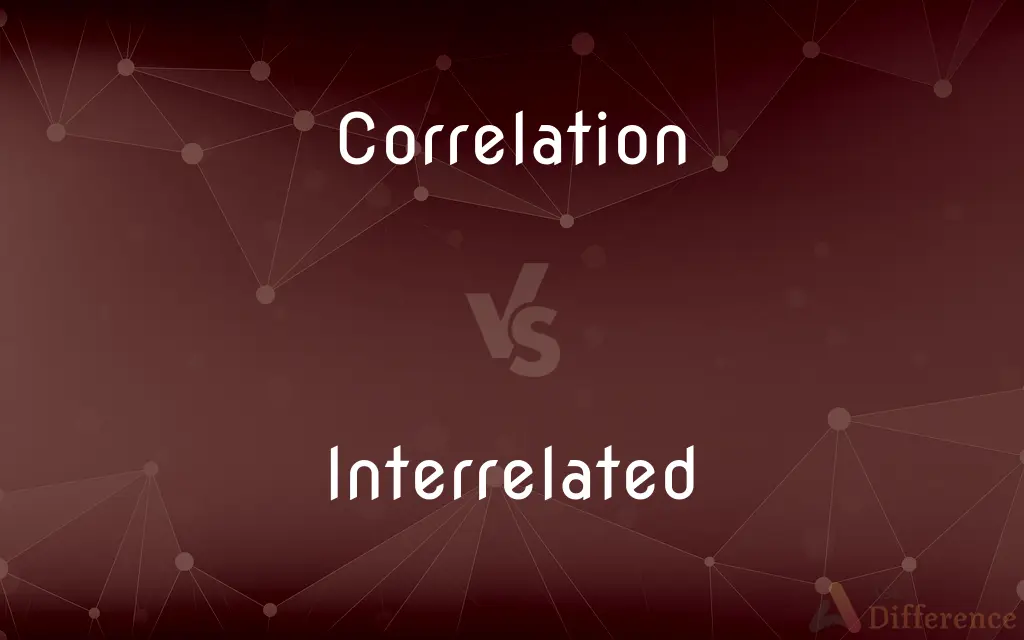Correlation vs. Interrelated — What's the Difference?
By Fiza Rafique & Maham Liaqat — Updated on March 30, 2024
Correlation quantifies the degree to which two variables change together, while "interrelated" describes a connection without specifying direction or strength.

Difference Between Correlation and Interrelated
Table of Contents
ADVERTISEMENT
Key Differences
Correlation is a statistical measure that expresses the extent to which two variables change together. If one variable tends to increase as the other increases, the correlation is positive; if one decreases as the other increases, it's negative. Correlation coefficients range from -1 to 1, quantifying the strength and direction of this relationship. On the other hand, "interrelated" refers to a more general concept of things being connected or related to each other in some way, without quantifying the strength or direction of the relationship.
While correlation provides a specific, measurable index of how variables are related, indicating the possibility of causation (but not proving it), being interrelated suggests a broader, potentially multidimensional relationship. For example, various factors may be interrelated in a complex issue, without clear, quantifiable correlations among them.
Correlation is often used in research to identify potential associations between variables that warrant further investigation. In contrast, describing phenomena as interrelated might be used in discussions where the nature of the connections is understood but not precisely measured, such as in theoretical frameworks or conceptual discussions.
In practice, identifying a correlation prompts further research to explore the underlying reasons for this relationship, potentially leading to the discovery of causal mechanisms. Recognizing that elements are interrelated, however, may guide holistic approaches to understanding a situation or problem, acknowledging that multiple factors are at play without isolating them for individual analysis.
The distinction between correlation and being interrelated is crucial in academic and professional contexts, guiding the approach to data analysis and problem-solving. While correlation seeks to quantify and test relationships, identifying as interrelated acknowledges complex connections that may require qualitative or systemic analysis to fully understand.
ADVERTISEMENT
Comparison Chart
Definition
A statistical measure that quantifies the degree to which two variables change together.
Describes a connection or relationship between two or more elements without specifying the nature of their relationship.
Quantification
Yes, typically ranging from -1 to 1.
No, it’s a qualitative description.
Direction
Yes, can be positive or negative.
Not specified.
Strength
Yes, indicated by the correlation coefficient.
Not indicated.
Application
Used in statistical analysis to explore potential associations.
Used to describe general connections in various contexts, including theoretical and practical discussions.
Implication for Causation
Suggests a relationship that might warrant further investigation for causation but does not imply causation itself.
Implies a connection that may be complex and multifaceted, often without direct implication for causation.
Compare with Definitions
Correlation
A statistical measure indicating the extent to which two or more variables fluctuate together.
A study found a strong correlation between exercise frequency and improved mood.
Interrelated
Refers to elements that are connected or related in a complex way, without specifying how.
Economic stability, health care access, and education levels are deeply interrelated factors affecting community well-being.
Correlation
Quantified by a correlation coefficient, revealing direction and strength.
The correlation coefficient of -0.8 suggests a strong negative correlation between stress levels and hours of sleep.
Interrelated
Emphasizes a holistic understanding of systems or issues.
The study highlighted how environmental, social, and economic factors are interrelated in urban development.
Correlation
Used to identify potential associations for further research.
Researchers observed a correlation between diet diversity and gut health, prompting further investigation.
Interrelated
Guides approaches to problem-solving that consider multiple dimensions.
Effective policy-making requires an understanding of how various societal issues are interrelated.
Correlation
Can be visualized through scatter plots to help identify patterns.
The scatter plot showed a clear positive correlation between age and financial literacy.
Interrelated
Used to describe conceptual or theoretical connections.
The concepts of freedom and responsibility are often seen as interrelated in philosophical discussions.
Correlation
Important in the development of predictive models.
Correlation analysis is crucial in building models that predict market trends based on historical data.
Interrelated
Recognizes the complexity of relationships without quantifying them.
The health of an ecosystem is interrelated with the biodiversity it supports.
Correlation
In statistics, correlation or dependence is any statistical relationship, whether causal or not, between two random variables or bivariate data. In the broadest sense correlation is any statistical association, though it commonly refers to the degree to which a pair of variables are linearly related.
Interrelated
To place in or come into mutual relationship.
Correlation
A relationship or connection between two things based on co-occurrence or pattern of change
A correlation between drug abuse and crime.
Interrelated
Having a mutual or reciprocal relation or parallelism; correlative.
Correlation
(Statistics) The tendency for two values or variables to change together, in either the same or opposite way
As cigarette smoking increases, so does the incidence of lung cancer, indicating a positive correlation.
Interrelated
Having a mutual or reciprocal relation or parallelism; correlative.
Correlation
An act of correlating or the condition of being correlated.
Interrelated
Reciprocally connected
Correlation
A reciprocal, parallel or complementary relationship between two or more comparable objects.
Correlation
(statistics) One of the several measures of the linear statistical relationship between two random variables, indicating both the strength and direction of the relationship.
Correlation
(algebra) An isomorphism from a projective space to the dual of a projective space, often to the dual of itself.
Correlation
Reciprocal relation; corresponding similarity or parallelism of relation or law; capacity of being converted into, or of giving place to, one another, under certain conditions; as, the correlation of forces, or of zymotic diseases.
Correlation
A reciprocal relation between two or more things
Correlation
A statistic representing how closely two variables co-vary; it can vary from -1 (perfect negative correlation) through 0 (no correlation) to +1 (perfect positive correlation);
What is the correlation between those two variables?
Correlation
A statistical relation between two or more variables such that systematic changes in the value of one variable are accompanied by systematic changes in the other
Common Curiosities
Is a high correlation coefficient enough to prove causation?
No, a high correlation coefficient indicates a strong relationship between variables but does not prove causation. Further causal research is necessary.
How can something be interrelated in a non-quantifiable way?
Elements can be interrelated through qualitative relationships or systemic connections that are observed or theorized but not easily measured with numbers.
Can two variables be interrelated without being correlated?
Yes, variables can be interrelated through complex mechanisms that don't result in a straightforward correlation measurable by statistical methods.
Does recognizing variables as interrelated imply a direction of influence?
No, describing variables as interrelated does not specify a direction of influence, unlike correlation, which can be positive or negative.
Can a single phenomenon be both correlated and interrelated with another?
Yes, phenomena can be statistically correlated in certain aspects while also being part of a broader, more complex network of interrelated factors.
How does understanding interrelatedness benefit problem-solving?
It encourages holistic approaches, considering multiple factors and their interactions, leading to more comprehensive and effective solutions.
Why is it important to distinguish between correlation and interrelatedness?
Distinguishing between them helps clarify whether we're discussing quantifiable relationships that can be statistically analyzed (correlation) or broader connections that require a different analytical approach (interrelatedness).
What role do correlations play in machine learning?
In machine learning, correlations help in feature selection, enabling the development of more accurate predictive models by identifying relevant variables.
How can technology help in understanding correlations and interrelatedness?
Advanced statistical software and data analysis tools can help identify and visualize correlations and complex relationships among variables.
How do researchers determine if variables are interrelated?
Researchers may use theoretical frameworks, qualitative analyses, and systemic reviews to understand how variables are interconnected.
Can interrelated elements be part of a causal chain?
Yes, interrelated elements can be part of complex causal chains, although identifying the specific nature of these causal relationships often requires detailed analysis.
What is an example of a misleading correlation?
An example is the "ice cream sales and shark attacks" correlation, where both increase during summer months, misleadingly suggesting a direct relationship when they are actually related to a third factor: warmer weather.
Why might two variables be interrelated but show a weak correlation?
They might influence each other in a complex system where other variables also play significant roles, diluting the apparent correlation.
Share Your Discovery

Previous Comparison
Discman vs. Walkman
Next Comparison
Class vs. DivisionAuthor Spotlight
Written by
Fiza RafiqueFiza Rafique is a skilled content writer at AskDifference.com, where she meticulously refines and enhances written pieces. Drawing from her vast editorial expertise, Fiza ensures clarity, accuracy, and precision in every article. Passionate about language, she continually seeks to elevate the quality of content for readers worldwide.
Co-written by
Maham Liaqat















































